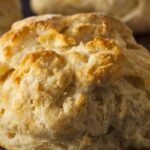Sour Milk Biscuits
This post may contain affiliate links, including those from Amazon.com, which means we earn a small commission off your purchases. And here's the thing: We only mention services and products that we think are truly worth your attention, whether they're free, paid, or otherwise. This site relies on YOUR trust, so if we don't stand behind a product 110%, it's not mentioned. Period.



These biscuits are a great way to use up your sour raw milk!
Sour Milk Biscuits
Ingredients
- 3 cups all-purpose flour, (~4 cups if using freshly ground flour – soft white wheat recommended)
- 2 ½ tablespoons evaporated cane sugar or honey
- 1 ½ tablespoons baking powder
- 1 teaspoon sea salt
- 8 tablespoons 1 stick cold butter, cubed
- ⅔ cup sour milk or buttermilk
- ½ cup whole milk
Instructions
- Prepare your oven and pans. Preheat the oven to 400°F. Line a baking sheet with parchment paper and set aside.
- Cut the butter into the dry ingredients. Sift or whisk together all dry ingredients. (If you're using honey rather than sugar, add it later by stirring it into the milks before adding it to the dough.) Cut and rub the butter into the flour mixture until it forms pea-sized pieces and loosely holds together when pressed in your hand.
- Make the dough. Add the sour milk and whole milk (and honey, if using). Mix just to combine the ingredients – don't overmix.
- Roll and shape the dough. Roll the dough out to a 1-inch thickness on a lightly floured work surface, fold in half, turn, and roll, fold, and turn again. Repeat the folding and rolling 3 or 4 times for a final thickness of 1 inch. Cut the dough into rounds using a 3-inch cutter, rerolling and cutting the scraps until you have 12 rounds.
- Bake the biscuits. Place the biscuits on the prepared baking sheet. Brush the tops with a little milk to make the tops shiny, if desired. Bake until golden brown, 15-18 minutes. Let cool on wire racks.
Notes
Sour Milk Biscuits
adapted from Baking at Home from the Culinary Institute of America
Makes approximately 12 biscuits
Ingredients:
3 cups all-purpose flour (~4 cups if using freshly ground flour – soft white wheat recommended)
2 1/2 Tbls. sugar or honey
1 1/2 Tbls. baking powder
1 tsp. sea salt
8 Tbls. (1 stick) cold butter, cubed
2/3 cup sour milk or cultured buttermilk
1/2 cup whole milk
Method:
Preheat the oven to 400 F.
Sift or whisk together all dry ingredients – if you're using honey rather than sugar, add it later by drizzling it into the dough when you add the milks. Cut the butter into the flour mixture until it forms pea-sized pieces and loosely holds together when pressed in your hand. Add the sour milk and whole milk. Mix just to combine the ingredients – don't overmix.
Roll the dough out to a 1-inch thickness on a lightly floured work surface, fold in half, turn, and repeat 3 or 4 times for a final thickness of 1 inch. (This process of laminating the dough ensures fluffy, flaky biscuits!) Cut the dough into rounds using a 3-inch cutter, rerolling and cutting the scraps until you have 12 rounds.
Place the biscuits on an ungreased baking sheet. Brush the tops with a little milk to make the tops shiny, if desired. Bake until golden brown, 10-15 minutes. Let cool on wire racks.
NOTE – November 2022: When I originally wrote this recipe more than a decade ago, I included a little side note that if you were grinding your own flour, I recommended using soft white wheat, as soft wheat produced the best texture in my own kitchen experiments. Recently, I discovered that my naivete actually hit on a key point in making flaky, melt-in-your-mouth biscuits. This article at The Atlantic beautifully explains why.






How do you get them browned on the top? Am I just not cooking them long enough?
That may depend on your oven. If your top element isn’t working or if the heat is too high, the bottoms would definitely brown much much faster than the bottom. It’s okay to pull them out when the bottoms are very brown even if the tops aren’t – as long as they’re baked through, it’s all good. 🙂
Can I make this recipe with just whole wheat flour? And just soured milk, instead of part sour/part fresh?
Yes, absolutely (for both questions)!